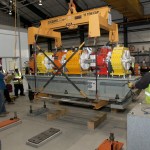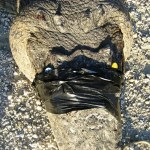magnets
A mere couple of weeks ago, I was beginning to “celebrate” a week designated to celebrate the sheer quackiness of the quackery that is naturopathy. True, that’s not what the woo-friendly Senators and Representatives who imposed Naturopathic Medicine Week 2014 on a disinterested world that didn’t need, want, or understand it. They represented it as a great thing, the “integrating” of the “best of both worlds,” those worlds to them being conventional science-based medicine and alternative medicine. To those of us who support science-based medicine, it was integrating cow pie with apple pie,…
Construction on Brookhaven's National Synchrotron Light Source II (NSLS-II) -- which will allow scientists to explore everything from fuel cell catalysts and soil samples to molecules vital for human life -- has passed the 50-percent completion mark.
The NSLS-II construction site
Work on the half-mile electron racetrack began in 2009 and is now more than a year ahead of schedule. In addition, conventional construction -- which covers everything from the roof and concrete floors to the plumbing and electricity -- is now complete on the first fifth of the ring. This milestone gives the…
Check out this awesome video of a computer-controlled swarm of magnetic bacteria building a pyramid out of tiny bricks!!!
From IEEE Spectrum, via It Takes 30, the always fascinating blog from Harvard Systems Biology, the department my lab is in!
Reader Fruity was the first to correctly name this device - on just the 9th comment. Impressive. Honestly, when I found this thing I had no clue. I asked other physicists and none of us were sure. However, I did find the answer. Let me show you my secret.
I don't know how old this thing is, but it is old. When I open it, my nose and eyes get all tingly - probably from the mold. Here is that apparatus in the book (tome):
I can't show you the whole page because it has other stuff of awesomeness that I want to show you later. But, I can show you the description for that item.
I am…
It was a time of fierce (but friendly) international competition, when physicists still built things with their own two hands. Dotted with barracks and trenches, Brookhaven was yet to fully transform its face from army camp to research institution.
In the early 1950s, the physics community was at the horizon of the boom of discoveries that define our understanding of the universe.
Before quarks, neutrinos, and CP violation could be found, scientists needed a tool much more powerful than Brookhaven's Cosmotron -- the leading particle accelerator of the time. The problem: building an…
Recent conservation efforts in the Florida Everglades to save the American crocodile from the brink of extinction have been effective: good thing. Territorial crocodiles hanging out in Floridian's back yards, however: bad thing. The worst part? Once a crocodile is removed from its favorite haunt, it will travel tens, sometimes hundreds of miles to return, using the Earth's magnetic field as a guide. Now the Florida Fish and Wildlife Conservation Commission has turned to an interesting method of deterring the crocs' return once they have been relocated - taping magnets to the crocodiles' heads…
Question from class: *What do magnets interact with?*
Basically, everyone said "metals". I am quite surprised. No one specifically indicated that magnets only interact with iron and steel (of the materials they would likely see). I understand that steel is a very common material they are likely to encounter, but what about aluminum? I think this points to the idea that very few of my students have actually played with magnets. This is a shame. Everyone loves magnets.
So, I propose you go out and give someone you love some magnets today.


